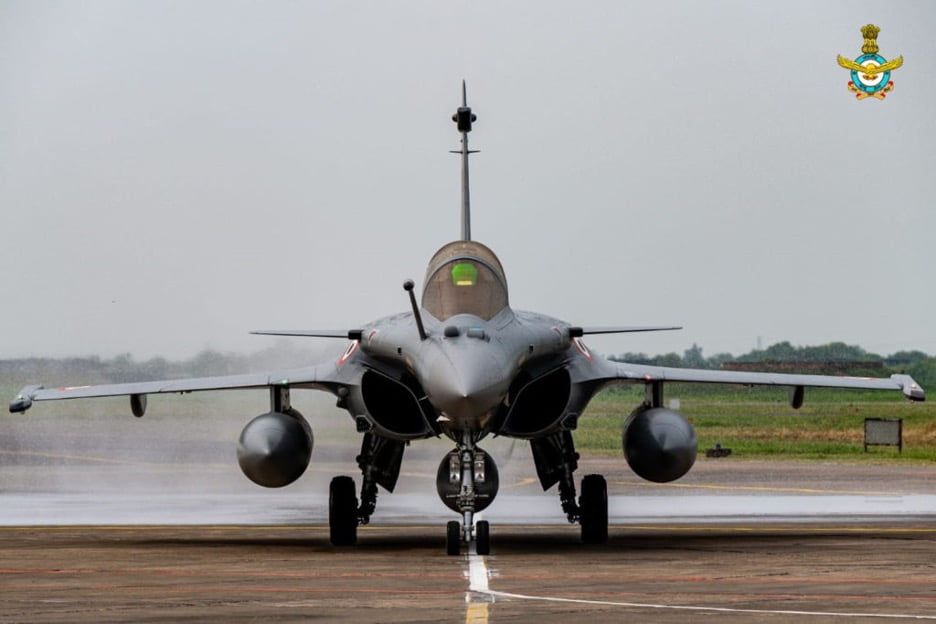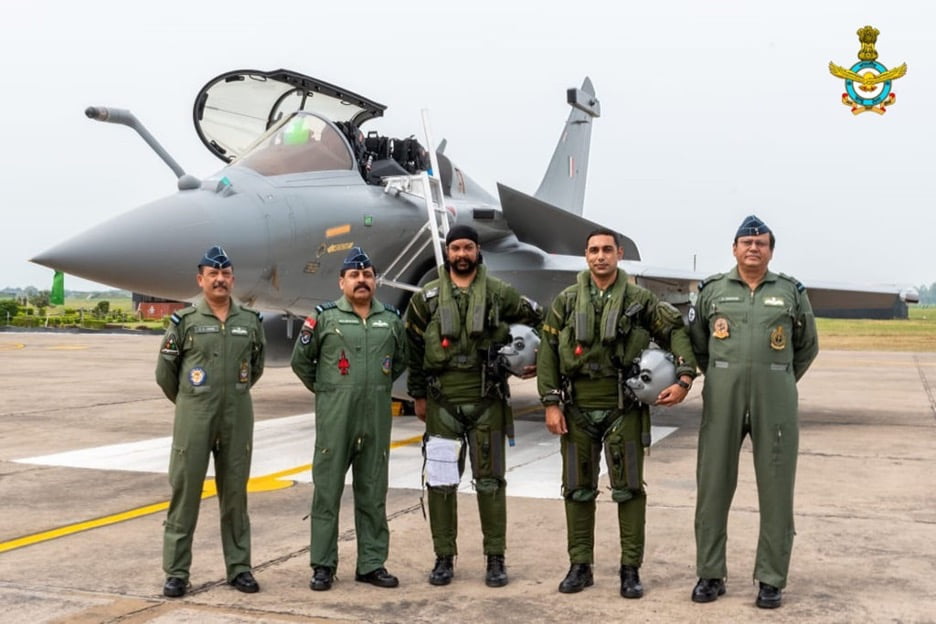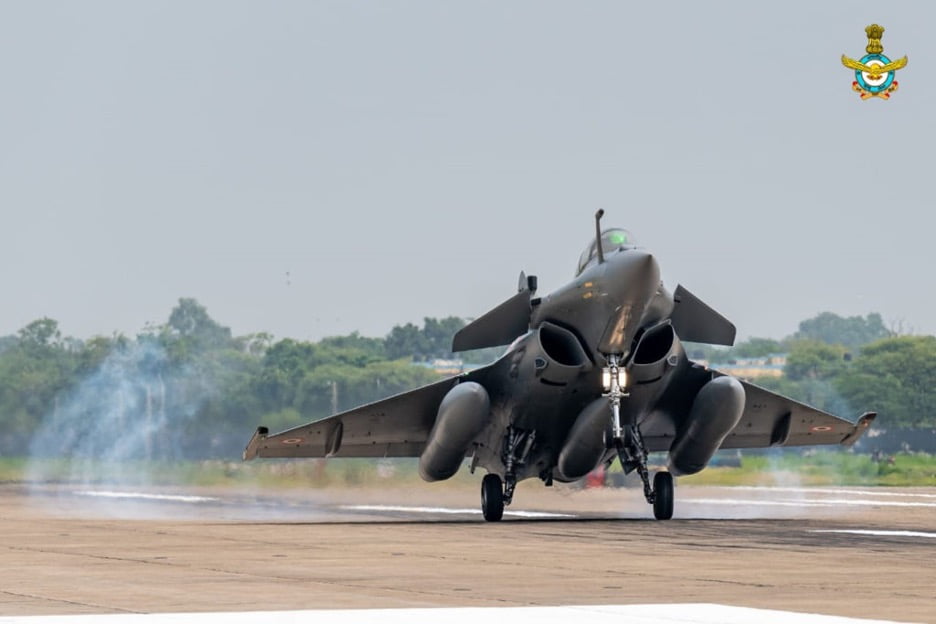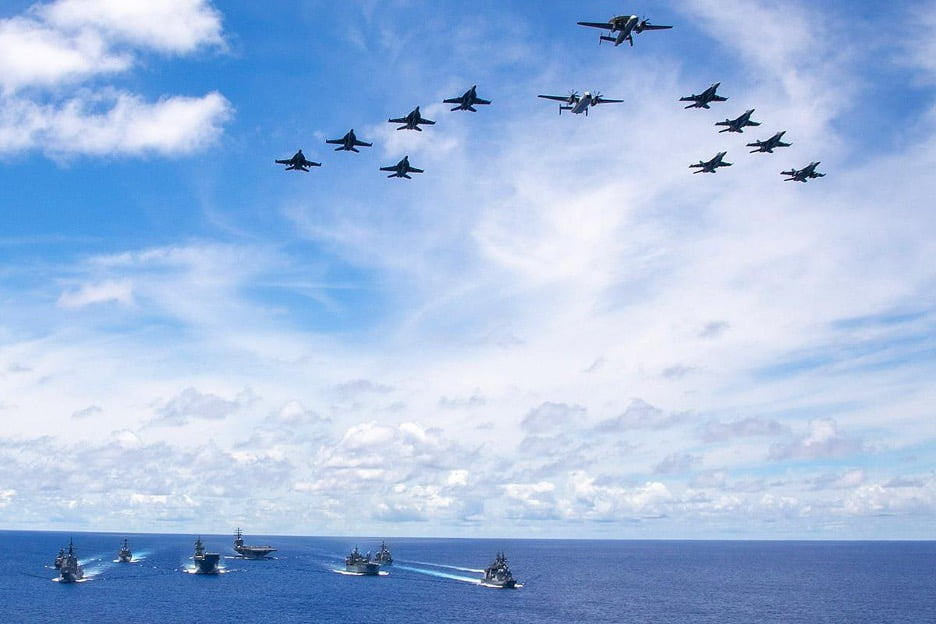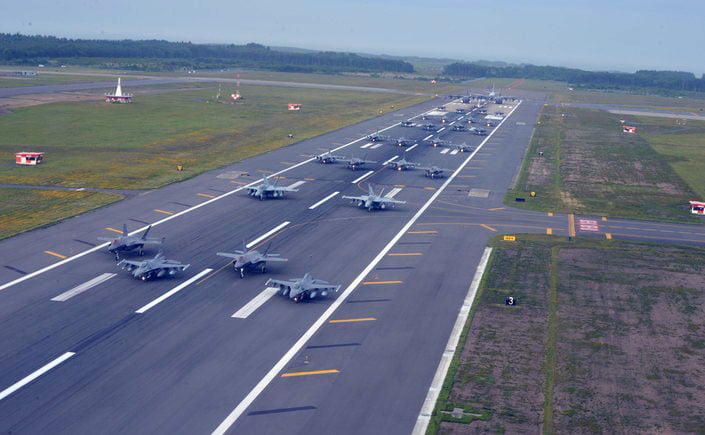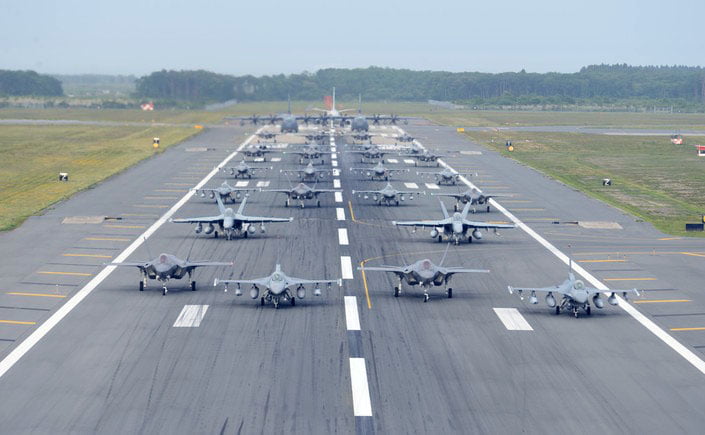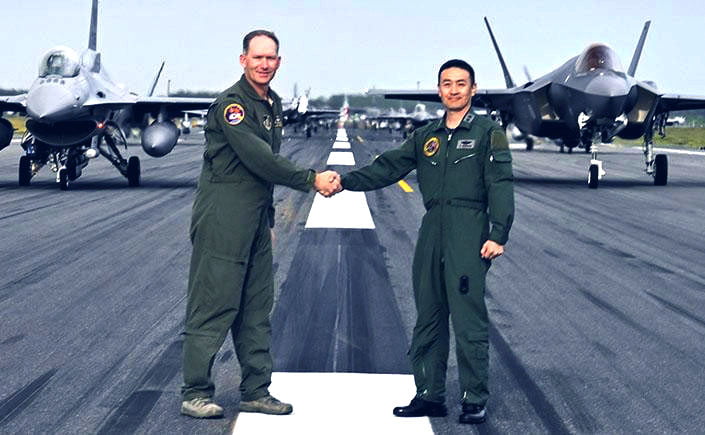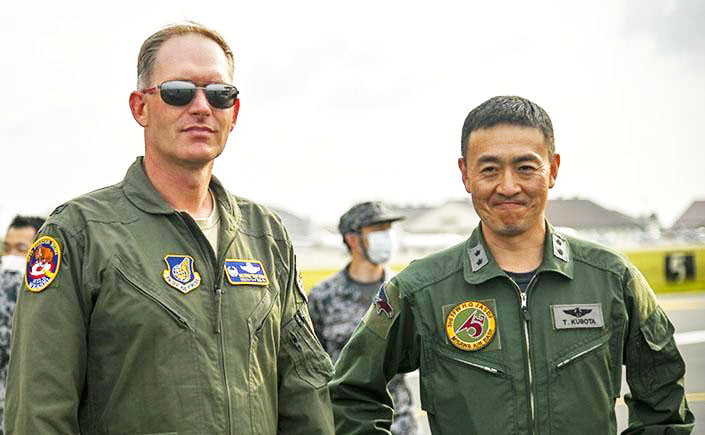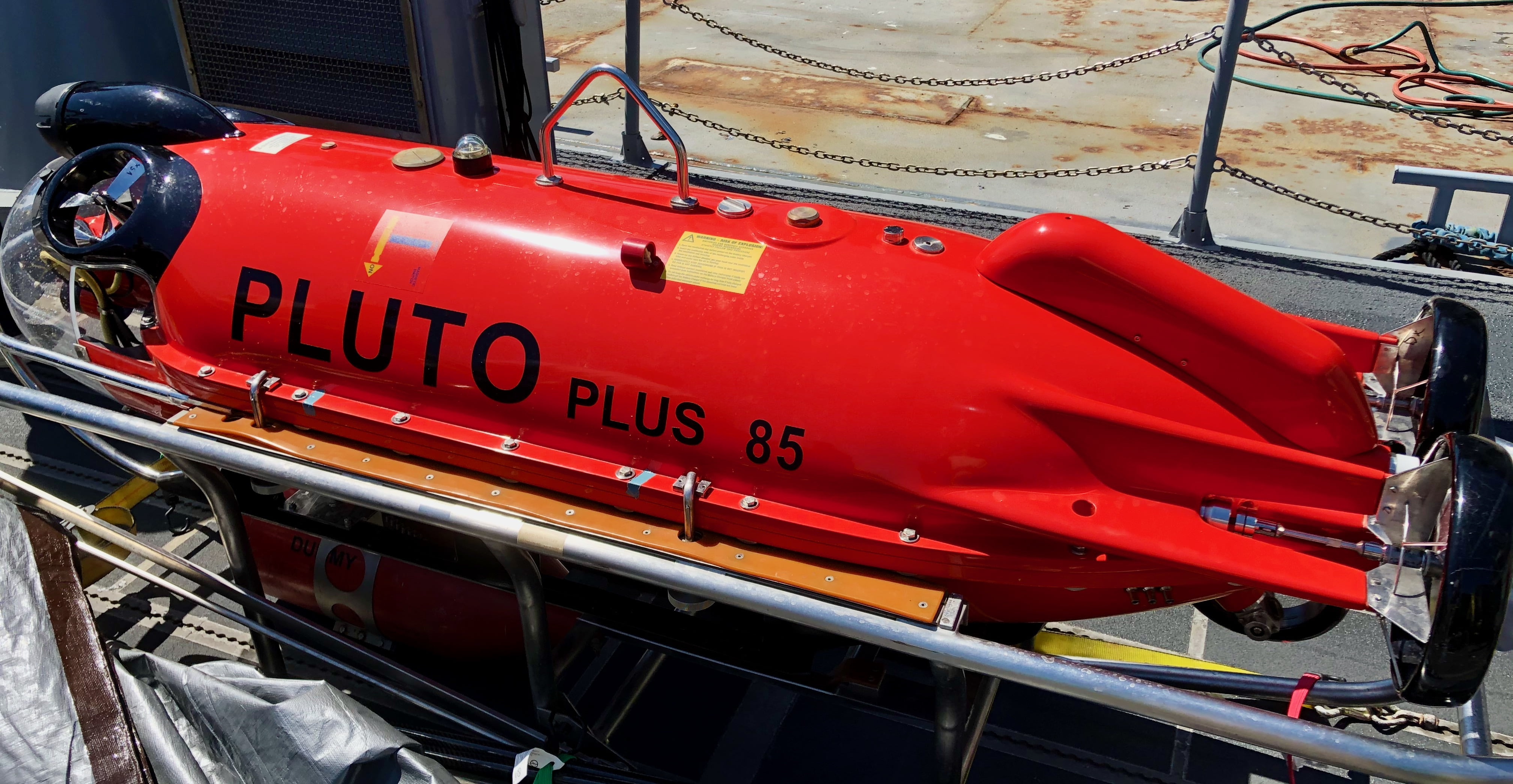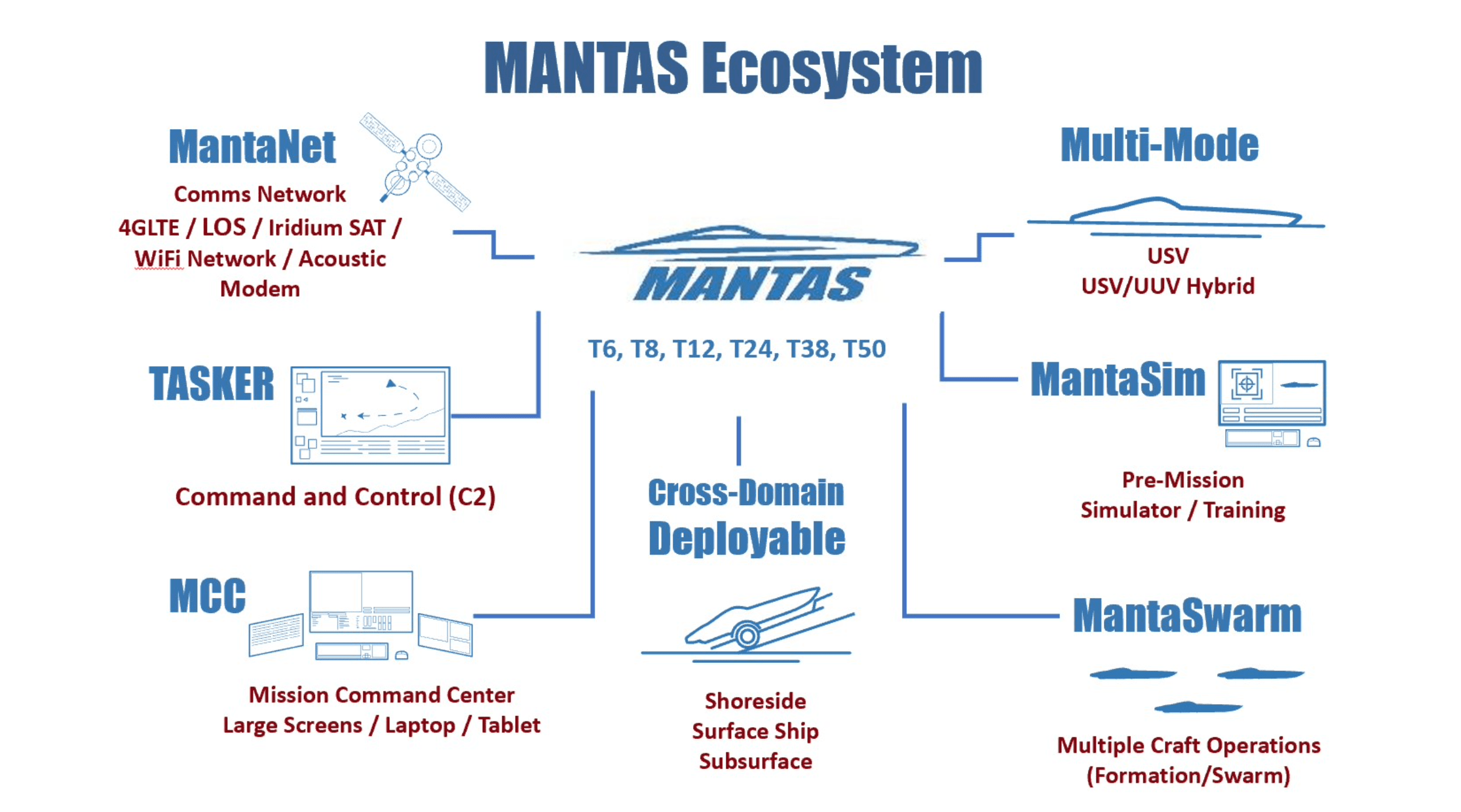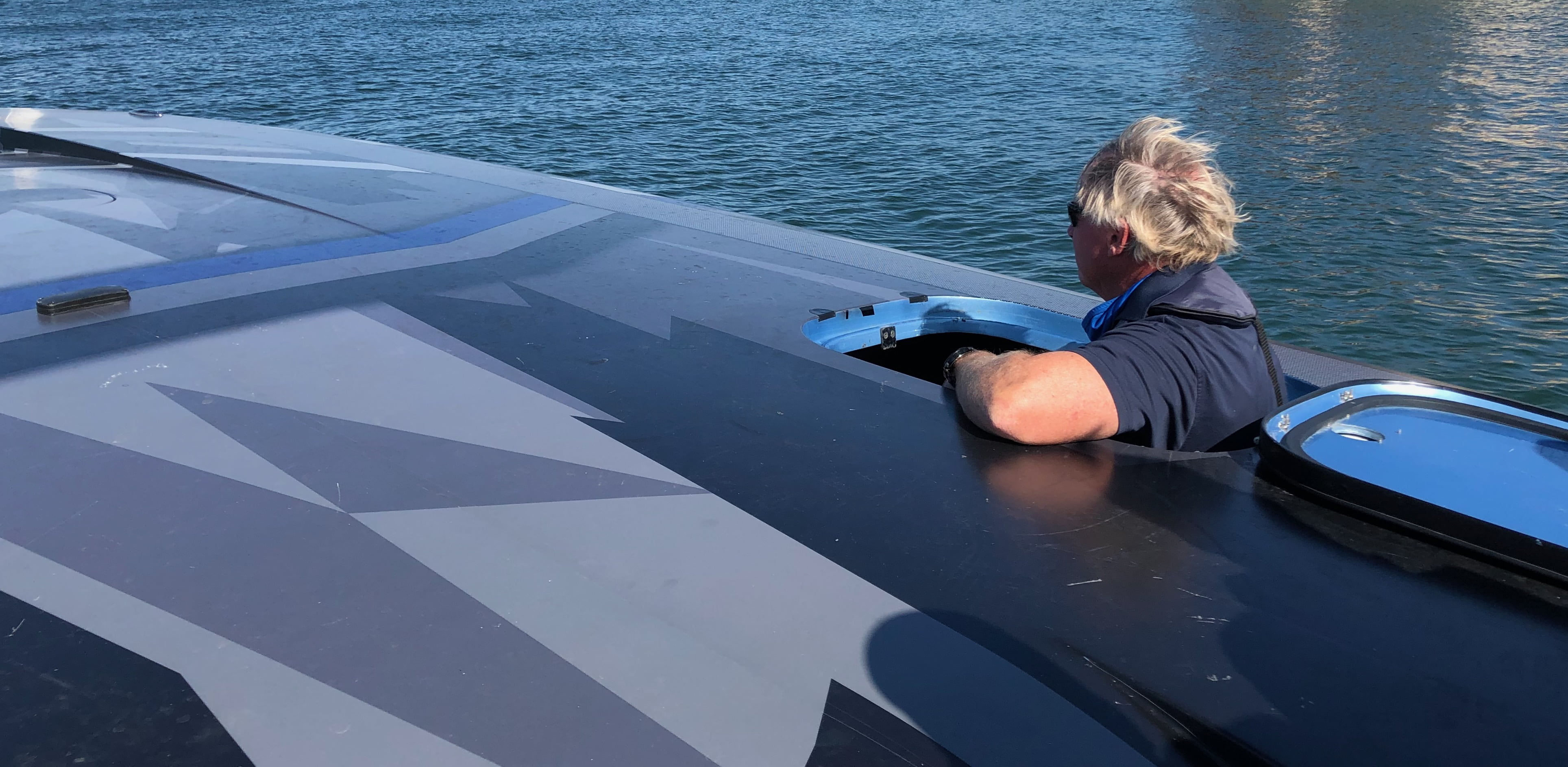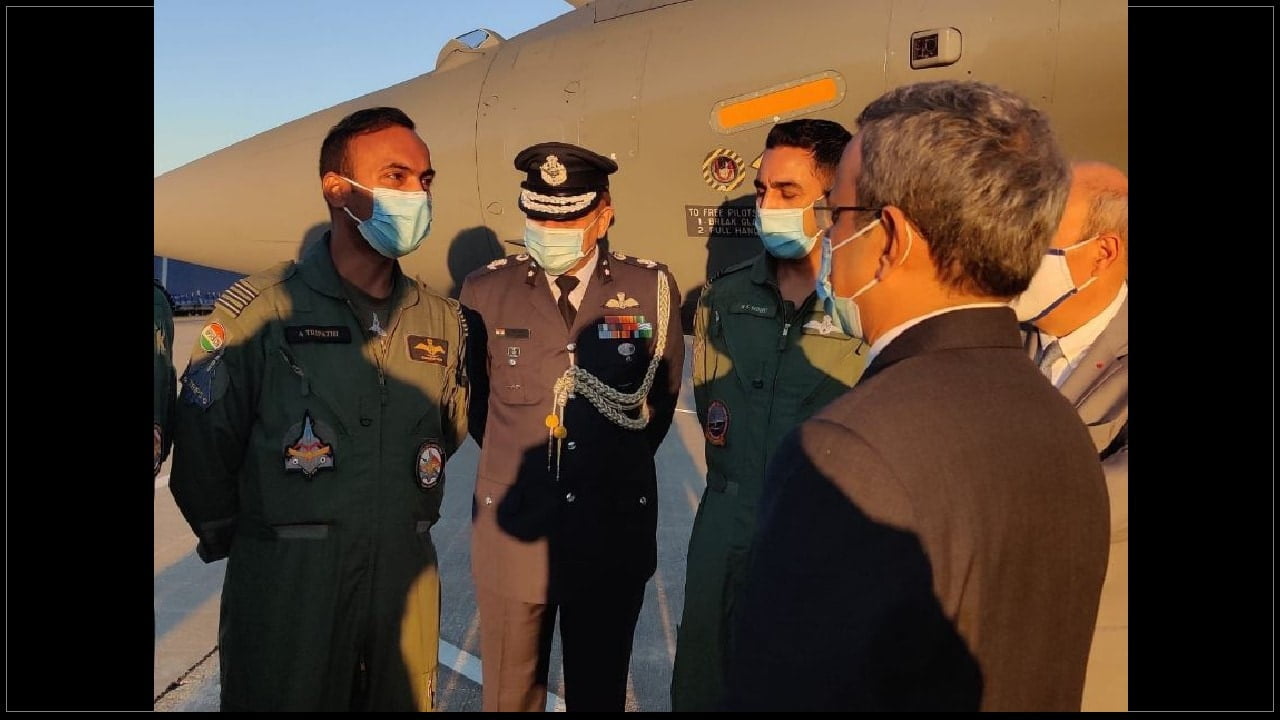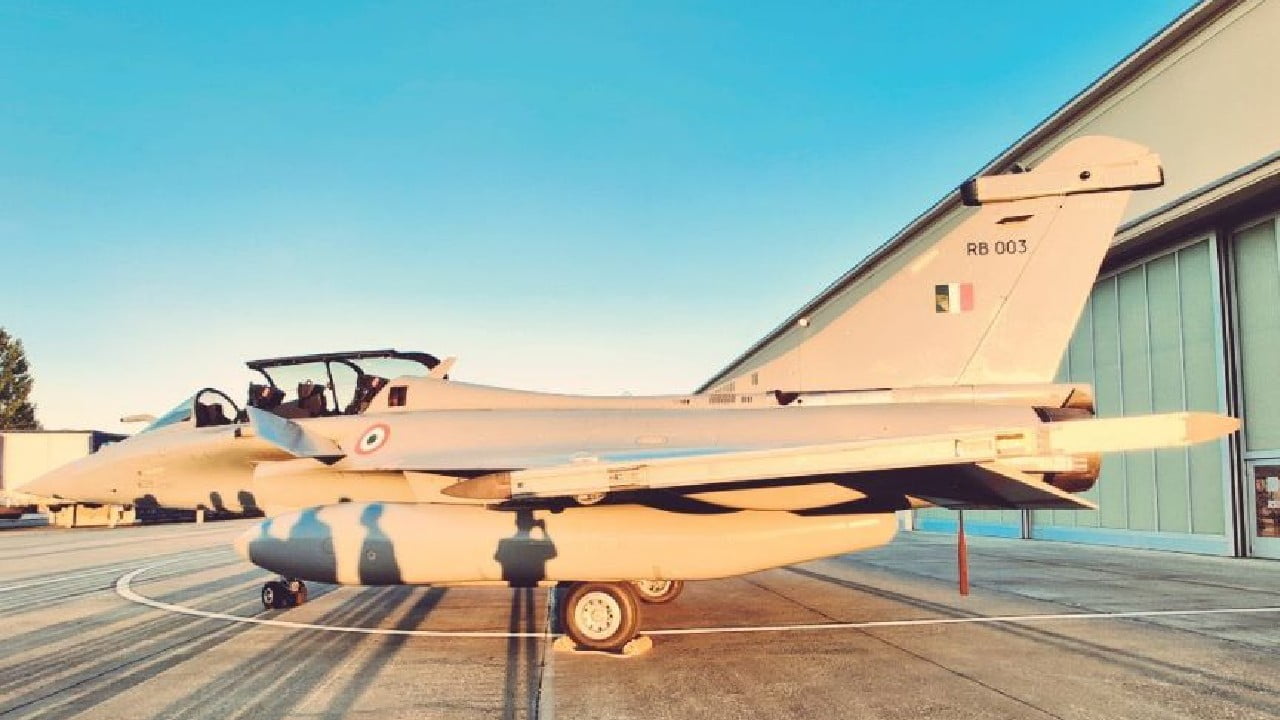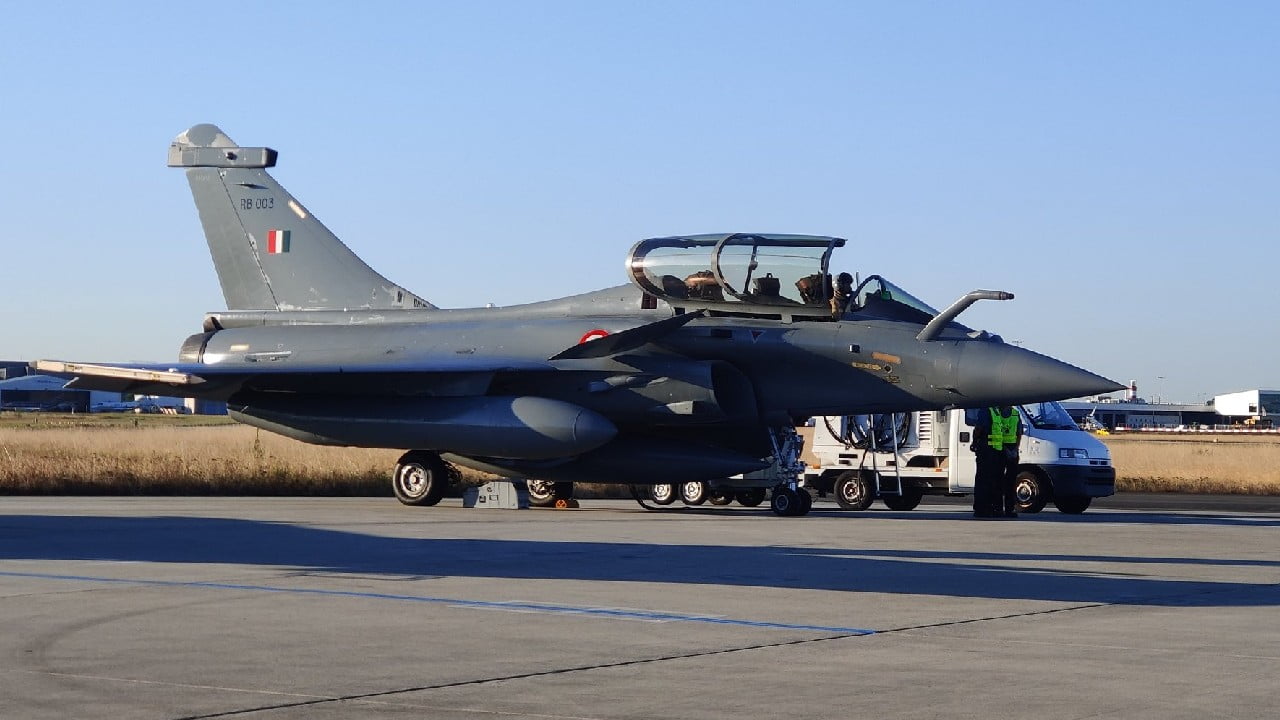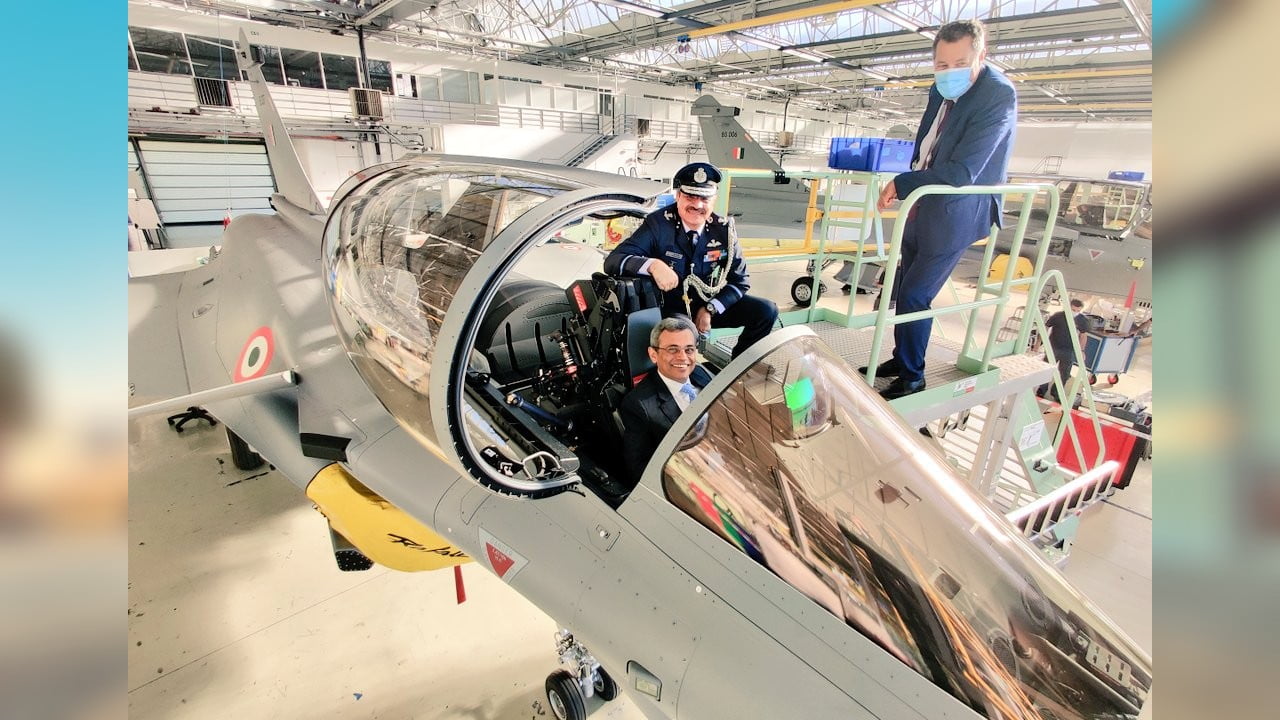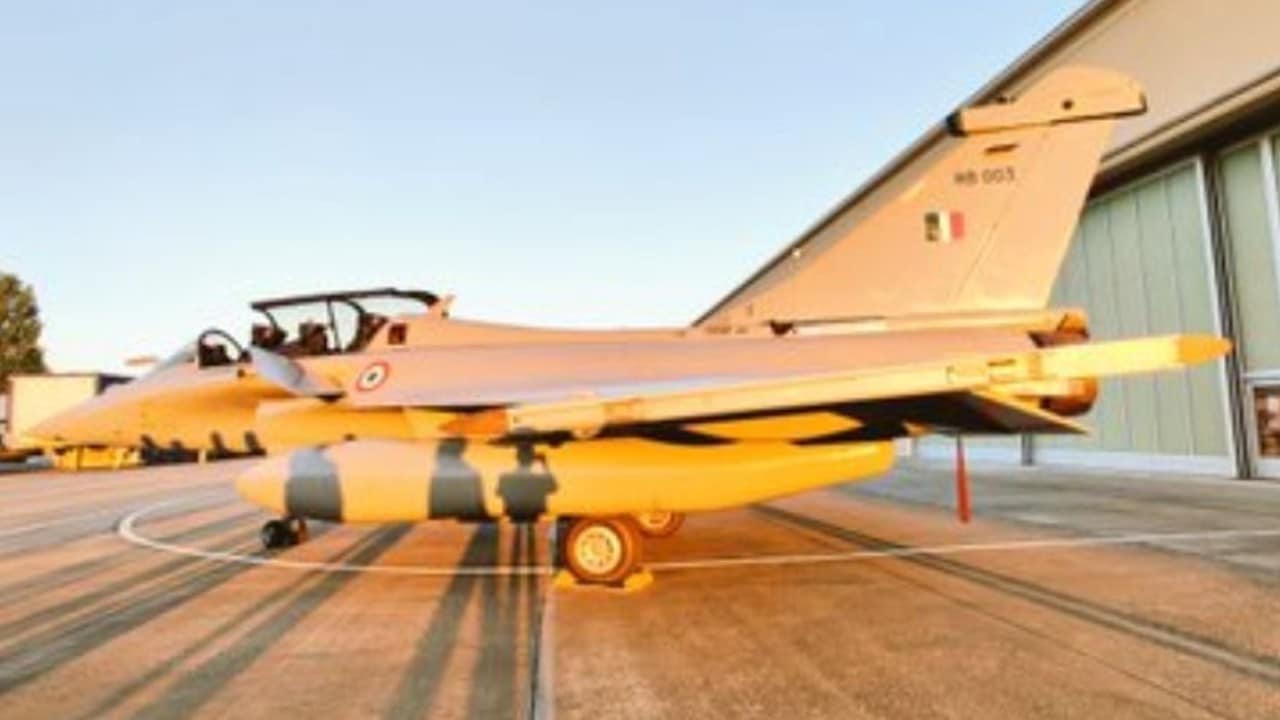By Air Marshal (Retd.) Anil Chopra
New Delhi. With war clouds on the Ladakh horizon, Indian Air Force (IAF) has received five Rafale combat jets, arriving at their Ambala airbase July 29.
IAF has already conveyed that the pilots are already fully trained and ready for any designated operational roles although a few days or weeks should be ideal for the pilots who flew the aircraft to India or have otherwise arrived after training in multirole operations both on simulators and onboard aircraft on simulated war conditions. Weapons for the weapons for the aircraft are already in India, and can be loaded swiftly as the software integration is preprogrammed for typically IAF requirements. The airbase infrastructure is operational and so are the technical facilities and administrative arrangements.
Air Chief Marshal RKS Bhadauria and Western Air Command C-in-C Air Marshal B Suresh welcomed the aircraft, led by Gp Capt Harkirat Singh, the Commanding Officer (CO) of the resurrected Golden Arrows Squadron 17.
Four pilots flew two twin seater Rafales, and three others the three single seaters. The aircraft were looked after by the French Air Force Armee de l’air up to UAE’s Al Dhafra airbase, and after that by IAF’s Su 30 MKIs. Midair refuelling was conducted on the France-UAE and UAE-India flights.
The Rafale Package
The 36 contracted aircraft include 28 single-seat and 8 dual-seat aircraft. The deal includes tailor-made enhancements for the IAF, a weapons package, and a performance-based logistics agreement.
The contracted weapons include MICA and Meteor Beyond Visual Range (BVR) air-to-air missiles and SCALP air-to-ground cruise missiles, as well as the Hammer, a French Safran’s Air to Ground precision missile.
The nearly dozen India-specific enhancements include the integration of an Israeli helmet-mounted display (HMD), radar warning receivers and low-band jammers. According to the deal, the delivery of the jets is to be completed in 67 months from the date the contract was inked. As per the schedule in the contract, the first aircraft was to be delivered in September 2019. Acceptance of an aircraft from the manufacturer involves physical check of ‘Standard of Preparation’, which includes every bit on board the aircraft, check of all supporting certification and maintenance documents, and flight testing the aircraft. An Indian team of flight test pilots and engineers was in France for this purpose, and training.
All activities have been on schedule on delivery count. All 36 jets are to be delivered by 2022.
Training in France
Normally, very professionally good personnel are chosen for training abroad. These personnel later become the nuclei for training the others in India. Training for IAF personnel included flying training for IAF pilots and technical training for engineers and technicians. Pilots have gone through full training on the operational systems and weapons exploitation. These France trained Indian pilots flew the aircraft to India.
IAF has acknowledged that the pilots, engineers and technical personnel have achieved operational training status.
Ferry To India
The aircraft departed from Bordeaux Merignac airfield on 27 July.
The 5 aircraft were accompanied by a large C 17 transport aircraft, carrying engineers, technicians and spare parts for technical support through the ferry. The plan was to have a single stop en route, at Al Dhafra airbase, Abu Dhabi. After two days or rest and turnaround time, the Rafales flew directly to Ambala.
Indian Navy warships on patrols in the region between India and the Gulf were the first to welcome the Rafales in the Indian Ocean. IAF and Navy was deployed in strength to ensure the safety of the aircraft and two IAF Su 30 MKIs
Squadron Formation
The 17 squadron ‘Golden Arrows’ which was ‘number-plated’ in 2016 was resurrected on 10 September 2019 at Ambala. This is the first Rafale squadron.
Interestingly, Air Chief Marshal BS Dhanoa had commanded this squadron during the Kargil war. Pilots trained abroad are being posted to this squadron, and they will also be the core group to formulate Standard Operating Procedures (SOPs), tactics and weapon system exploitation for fleet operations in India. Engineers and technicians will formulate maintenance SOPs. This core group would also split into two to form the second Rafale squadron at Hashimara in the east a year later.
Station Infrastructure
Ambala was the mother base to the initial induction of Jaguars and MiG 21 Bison aircraft, among others. The airbase is nearly 200 km from India’s Western border, and by distance it mirrors Pakistan’s most important airbase of Sargoda. This distance gives enough depth and yet is near enough to launch offensive missions across western border.
Interestingly it is also just 200 km from the China border and the location supports missions against China. The Chinese airbase at Ngari Gar Gunsa opposite Leh is a little over 300 km from Ambala. China is in news these days because of its attacks on Indian troops along the Line of Control and resultant fatalities on both the sides.
Infrastructure at Ambala airbase, to house the Rafales, has been coming up for some time. Specific-to-type blast pens, technical infrastructure including avionics and electronic warfare systems laboratories, weapon preparation areas etc., have been built or re-appropriated. Specific flight safety requirements have been dove-tailed into the Station plan. The Rafale simulator and the type-training TETTRA school is coming up there. Facilities for engine test-bench may be required.
Later similar infrastructure will come up at Hashimara, which is a base near critical areas of Sikkim, Bhutan and Arunachal. The programme is to keep one Squadron each of the Rafales at the two airbases.
Rafale – the Weapon Platform
Rafale is a twin-engine, delta-wing, 4th plus generation fighter with semi-stealth capabilities. It is an agile aircraft and capable of simultaneously packaging and conducting air superiority, interdiction, reconnaissance, and airborne nuclear deterrent missions, with fire and forget capability, enabling a pilot to easy move from one mission to another.
The aerodynamically unstable aircraft uses digital fly-by-wire flight controls. The actively coupled canard wing allows high manoeuvrability. The aircraft is designed for reduced radar cross-section (RCS) and infra-red signature. There is extensive use of composite materials. The glass cockpit is designed around the principle of data fusion. A central computer prioritizes information to display to pilots for simpler command and control.
The Rafale is fitted with two Snecma M88 engines, each capable of providing up to 50 kilo-Newton (kN) of dry thrust and 75 kN with afterburners. The engines feature several advances, including a non-polluting combustion chamber, single-crystal turbine blades, and powder metallurgy disks, and technology to reduce radar and infrared signatures. The engine is of a modular design for ease of maintenance and upgrades. A thrust vectoring variant of the engine designated as M88-3D is also under development.
The Rafale also features an advanced avionics suite. The total value of the radar, electronic communications and self-protection equipment is about 30% of the cost of the entire aircraft.
The aircraft’s RBE2 AA active electronically scanned array (AESA) radar has been fully tested operationally. It has a field of regard of 70° on either side of the aircraft axis, and extended range capabilities supporting low-observable target detection. Its SAR (Synthetic Aperture Radar) imaging and improved resistance to jamming. Rafale makes extensive use of radar-absorbent materials (RAM). The SPECTRA integrated electronic warfare suite provides long-range detection, identification and accurate localization of infrared homing, radio-frequency and laser threats. The system incorporates radar warning receiver, laser-warning, Missile Approach Warning (MAW) for threat detection plus a phased array radar jammer and a decoy dispenser for threat countering. It also includes a dedicated management unit for data fusion and reaction decision. The Thales/SAGEM Optronique Secteur Frontal Infra-Red Search and Track (IRST) system uses a narrow field for tracking air targets at ranges up to 100 kilometers. A TV/IR sensor for target identification (40 km range) including laser rangefinder.
Notably, IRST was an IAF-specific requirement, included in the 2007 tender for 126 Medium Multi Role Combat Aircraft (MMRCAs).
A host of latest weapons would also get inducted. The aircraft has a 30 mm cannon with 125 rounds. The 14 hard-points can carry 9,500 kg external loads. The air-to-air missiles include MBDA MICA IR or EM, and MBDA Meteor.
Meteor is an active radar guided, beyond-visual-range air-to-air missile (BVRAAM). Meteor offers multi-shot capability against long range maneuvering targets, jets, UAVs and cruise missiles in a heavy electronic countermeasures (ECM) environment with range well in excess of 150 kilometers. The no-escape zone of over 60 km is the largest among air-to-air missiles according to the manufacturing company, Dassault.
A solid-fueled ramjet motor allows the missile to cruise at a speed of over Mach 4. Among the host of air-to-ground weapons is MBDA Storm Shadow/SCALP-EG cruise missile with 450 kg warhead and 560 km range. The aircraft has been used in combat in Iraq, Afghanistan, Libya, Mali and Syria, proving new levels of technology.
Based on the Mirage-2000 experience, it is likely to have a much higher serviceability, low turn-around time, and high mission accomplishment rate. There is already a proposal to acquire (On fast track) the HAMMER (Highly Agile Modular Munition Extended Range) Air-to-Ground Modular Weapon (AASM) made by Safran, and already integrated in Rafale’s software.
AASM comprises a frontal guidance kit and a rear-mounted range extension kit matched to a dumb bomb. The basic version features a 250-kilogram bomb. There are also versions with 125, 500 or 1,000-kilogram bomb bodies. Typically the weapon has a range of around 60 km.
Operational Preparation and Deployment
It shall be the endeavour of IAF to quickly make the fleet fully operational, and they will start flying operational missions along with the radar controllers, typically to hone their weapon delivery skills in different terrains. Then, they will begin evolving Dissimilar Air Combat Tactics (DACT) with other fleets.
Rafales will fly mixed formation missions in realistic war-like scenarios. They will fly network-centric missions in different roles, including air strikes, air-defence and electronic support roles. They will also take part in inter-service joint exercises. They would also fly coordinated missions with strategic assets like air-refueler and AWACS.
In view of the stand-off with China, the normal time frame for fleet operationalisation of 4-6 months would now be compressed to maybe 1-2 months. The French companies have worked closely with IAF for decades on the Mirage 2000 fleet which continues to be the weapon platform of choice for IAF. Rafale operationalisation may therefore take much lesser time.
Compared To Other Aircraft in the Region
Among the main Chinese fighters is the Chengdu J 10 which is essentially a modified Israeli “Lavi” aircraft, which itself was derived from the American F 16 base model. It can best be considered equivalent to the F 16 A/B. China has over 400 of these, although Chinese engineers have also stolen tech from the Pakistani F 16s.
The J 10 can carry the PL 12 BVR missile with a range of 70-100 km.
The Shenyang J-11 is a Chinese copy of the Soviet Union’s Su 27. It also carries the PL 12 missile. It is much inferior to the Indian Su 30 MKI. China developed the Shenyang J 16 fighter based on the J 11B airframe, with modifications from the Russian Sukhoi Su-33MKK that was sold to China in 2000. They have around 130 of them.
They also carry the PL 12 and may carry the longer range PL 15 missile. The PL 15 may have range of around 150 km, though Chinese propaganda claims it has range in excess of 200 km.
China also has the Su 30 MKK which is similar to IAF’s Su-30 MKI.
Then there is just one squadron of Russian Su 35, which is a more advanced variant of the Su 30 MKK. Maybe they have bought it for reverse engineering and stealing its technology, of which it has been accused of by Russia. China’s latest fifth generation fighter J 20 is just entering service in small numbers and will take some time to be operational.
IAF’s combination of Rafale, Su 30 MKI, and upgraded Mirage 2000 and MiG 29 aircraft will be a formidable combination and challenge to PLAAF. In addition, the Jaguar, MiG 21 Bison and the indigenous LCA Mk1 make great fighter assets.
The Rafale clearly stands out to be much better and operationally tested fighter compared to all Chinese assets. The best aircraft with Pakistan is the F 16 Block 52 with its AMRAAM missile (120 km range). Most top end IAF fighters have an edge over this aircraft.
Rafale is the Game Changer
Equipped with a wide range of weapons, the Rafale can perform air supremacy, interdiction, aerial reconnaissance, deep ground strike, anti-ship strike and nuclear deterrence missions. The Rafale is referred to as an “omnirole” aircraft by Dassault. The class and range of the AESA radar, IRST, avionics, fused data, stealth features, SPECTRA protection suit, and most importantly the weapons put it in a different class both on western and northern borders.
The Rafale is likely to maintain high availability and mission success rate.
However, as only 36 aircraft are being acquired, they make an odd figure as two squadrons actually require three aircraft more for each for training and reserve as per the established IAF squadron strength. Possibly, as has been done in the past, a follow-on order for another 36 could be given to make viable operational numbers.
There is a 50 percent Offsets clause in the Rafale contract, and part of that is already being fulfilled towards encouraging the Make-in-India requirements.
The Rafale, as Prime Minister Narendra Modi has said, will be a game changer in the region on many counts.
– The Author has been a pioneer of Mirage 2000 fleet and has watched the induction and operationalisation of a French fighter fleet closely.
This article was published by our partner India Strategic on July 29, 2020.
Also, see:
Indian Air Modernization Takes a Significant Step Forward: First Rafales Depart France for the Indian Air Force


